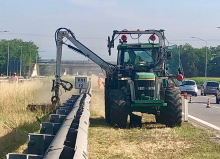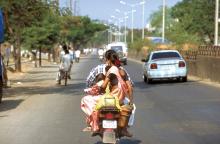Extreme weather conditions cost the EU’s transport system at least €15 billion/year. This is the result of a study carried out by the Finnish VTT Technical Research Centre. The study reveals that the greatest costs incurred are from road accidents, with the associated material and psychological effects. Costs arising from accidents are expected to decrease in volume, although time-related costs attributable to delays are projected to increase. In part, this last effect is due to climate change, which has an
Extreme weather conditions cost the EU’s transport system at least €15 billion/year. This is the result of a study carried out by the 3483 Finnish VTT Technical Research Centre.
The study reveals that the greatest costs incurred are from road accidents, with the associated material and psychological effects. Costs arising from accidents are expected to decrease in volume, although time-related costs attributable to delays are projected to increase. In part, this last effect is due to climate change, which has an impact on extreme weather phenomena.
The researchers calculated the costs caused by extreme weather phenomena for the transport system, its users and customers of freight carriers in the 27 EU member states. This marks the first time calculations have been completed on this scale and scope. The results of the study show that road traffic is the mode of transport most vulnerable to extreme weather. Road traffic has a higher volume than the other transport modes, with the additional factor of not being centralised or professionally controlled, in contrast to rail or aviation. In particular, the consequences of extreme weather are visible in road traffic in the form of increased road accidents and the associated costs. In other traffic modes, it is far more likely that there will be time-related delays rather than accidents. Aviation in particular is prone to time-related delays in extreme weather.
In road traffic, heavy time-related costs are particularly frequent in freight traffic. At EU level, annual losses, measured to be around 6 € billions annually, are suffered by the customers of freight carriers as a result of time-related costs, and here is a risk of continued growth in costs. This is due to the growth in volumes of freight-carrying traffic, which is forecast at 1-2 per cent a year. Furthermore, improved efficiency in production chains accentuates the importance of adherence to timetables, creating further potential for growth in time-related costs.
Passengers in road traffic will incur time-related costs, as extreme weather conditions slow down traffic, keeping people away from productive work. At the same time, however, road accidents will be on the decline in the EU. VTT’s researchers estimate that improvements to vehicle safety, along with the warming caused by climate change, may reduce the cost arising from road accidents by as much as half by 2040 -2070.
The impact of climate change is difficult to predict.
However, the impact of climate change on extreme weather conditions, along with the cost arising from such conditions, is hard to estimate with any accuracy. In the North, where most costs incurred by traffic are attributable to snow and ice, heavy snowfalls may actually become more frequent, despite climatic warming. In Southern Europe, one cost factor to be reckoned, but which is studied far too little, with in the future may be heat waves, leading to decreased pedestrian traffic and cycling, and to increased motorised traffic. Moreover, as droughts grow in frequency, so will sand storms and dust storms, and as heat waves are followed by torrential rains, soil will become less firm, creating potential for landslides.
The traffic mode least affected by extreme weather is sea traffic. However, transport by sea is no solution to the problem of the time-related costs, experienced by European transport traffic, because cost-efficiency continues to be the factor that dictates the choice of transport mode. Bulk freight is transported by rail or waterways, with lower average speeds but a better guarantee against the vagaries of weather. High-priced freight, sensitive to schedule disruptions, is transported by road and air, which are fast transport modes but susceptible to the whims of extreme weather.
In conditions that are extreme but at the moderate end of the scale, time-related costs can be cut by means of intensified maintenance measures and improved communications. Unfortunately, the consequences of genuinely extreme weather phenomena are hard to predict and prevent. A decrease in traffic volume would have the most beneficial impact, brought about through improved mass transport, virtual presence communications, and remote work. As a bonus, this would make traffic more manageable not just for professional drivers; it would also help minimise the environmental impact created by road traffic.
The report “The costs of extreme weather for the European transport systems.6133 EWENT project D4”, is available at %$Linker: External 0 0 0 oLinkExternal http://www.vtt.fi/inf/pdf/technology/2012/T36.pdf PDF technology 2012 false http://www.vtt.fi/inf/pdf/technology/2012/T36.pdf false false %>
EWENT consortium includes:
EWENT is financed by the European Union under the 7th Framework Programme
The study reveals that the greatest costs incurred are from road accidents, with the associated material and psychological effects. Costs arising from accidents are expected to decrease in volume, although time-related costs attributable to delays are projected to increase. In part, this last effect is due to climate change, which has an impact on extreme weather phenomena.
The researchers calculated the costs caused by extreme weather phenomena for the transport system, its users and customers of freight carriers in the 27 EU member states. This marks the first time calculations have been completed on this scale and scope. The results of the study show that road traffic is the mode of transport most vulnerable to extreme weather. Road traffic has a higher volume than the other transport modes, with the additional factor of not being centralised or professionally controlled, in contrast to rail or aviation. In particular, the consequences of extreme weather are visible in road traffic in the form of increased road accidents and the associated costs. In other traffic modes, it is far more likely that there will be time-related delays rather than accidents. Aviation in particular is prone to time-related delays in extreme weather.
In road traffic, heavy time-related costs are particularly frequent in freight traffic. At EU level, annual losses, measured to be around 6 € billions annually, are suffered by the customers of freight carriers as a result of time-related costs, and here is a risk of continued growth in costs. This is due to the growth in volumes of freight-carrying traffic, which is forecast at 1-2 per cent a year. Furthermore, improved efficiency in production chains accentuates the importance of adherence to timetables, creating further potential for growth in time-related costs.
Passengers in road traffic will incur time-related costs, as extreme weather conditions slow down traffic, keeping people away from productive work. At the same time, however, road accidents will be on the decline in the EU. VTT’s researchers estimate that improvements to vehicle safety, along with the warming caused by climate change, may reduce the cost arising from road accidents by as much as half by 2040 -2070.
The impact of climate change is difficult to predict.
However, the impact of climate change on extreme weather conditions, along with the cost arising from such conditions, is hard to estimate with any accuracy. In the North, where most costs incurred by traffic are attributable to snow and ice, heavy snowfalls may actually become more frequent, despite climatic warming. In Southern Europe, one cost factor to be reckoned, but which is studied far too little, with in the future may be heat waves, leading to decreased pedestrian traffic and cycling, and to increased motorised traffic. Moreover, as droughts grow in frequency, so will sand storms and dust storms, and as heat waves are followed by torrential rains, soil will become less firm, creating potential for landslides.
The traffic mode least affected by extreme weather is sea traffic. However, transport by sea is no solution to the problem of the time-related costs, experienced by European transport traffic, because cost-efficiency continues to be the factor that dictates the choice of transport mode. Bulk freight is transported by rail or waterways, with lower average speeds but a better guarantee against the vagaries of weather. High-priced freight, sensitive to schedule disruptions, is transported by road and air, which are fast transport modes but susceptible to the whims of extreme weather.
In conditions that are extreme but at the moderate end of the scale, time-related costs can be cut by means of intensified maintenance measures and improved communications. Unfortunately, the consequences of genuinely extreme weather phenomena are hard to predict and prevent. A decrease in traffic volume would have the most beneficial impact, brought about through improved mass transport, virtual presence communications, and remote work. As a bonus, this would make traffic more manageable not just for professional drivers; it would also help minimise the environmental impact created by road traffic.
The report “The costs of extreme weather for the European transport systems.
EWENT consortium includes:
- VTT
-
6134 German Aerospace Center - Institute of Transport Economics (NO)
-
6138 Foreca Consulting Ltd (FI) -
3966 Finnish Meteorological Institute - Meteorological Service of Cyprus,
6135 Via Donau (AT) -
6136 European Severe Storms Laboratory (DE) -
6137 World Meteorological Organisation (UN)
EWENT is financed by the European Union under the 7th Framework Programme






